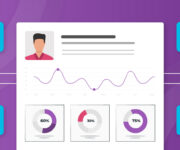The traditional process for disbursing commercial loans relies heavily on manual workflow, making it time-consuming and prone to errors. As the demand for credit by businesses and MSMEs increases rapidly, lenders seek contemporary solutions such as commercial loan management software that help them improve their efficiency and meet customer expectations.
As of the latest available data, the total value of loans in India reached approximately $2,048 billion USD by December 2024, according to CEIC Data. This figure encompasses all loan types, including commercial, retail, and MSME loans.
In response to these challenges, commercial loan management software offers the perfect solution for lenders by helping them automate the entire lending process and optimise their workflow, allowing them to process more loans in less time and with fewer errors. Let us explore how.
What Is a Commercial Loan Management Software Tool?
Commercial loan management software is a cloud-based solution, often powered by artificial intelligence, that helps lenders automate their lending process. It is a unified platform that enables the smooth processing of various phases like loan origination, processing, disbursal, and monitoring loans to commercial borrowers.
These lending systems incorporate modern technology and rely on predictive analytics, data analytics, and more to help businesses improve their operations, profitability, and customer satisfaction.
How Does Modern Commercial Loan Management Software Transform the Lending Experience?
A superior commercial loan management software typically incorporates the following aspects:
- Processing of multi-loan types
- Flexible repayment frequencies
- Multi-disbursement
- Flexible payments module
- Dynamic loan document generation
- Bank payment reconciliation
- Non-performing assets management
Here’s how the modern lending system helps transform the lending process in the following ways:
1. Automation-driven Faster Disbursal
Businesses generally have diverse credit needs ranging from short-term to long-term, as well as equipment financing to bill discounting.
Loan management systems automate each step of the lending process and help lenders navigate simple and complex loan disbursals efficiently and quickly. As a case in point,
Finezza’s AI-driven loan management system offers support for tenure loans, overdrafts, equipment financing, revolving credit and more, allowing for a hassle-free user experience for all credit needs of the customer.
This is how Commercial loan management software empowers banks to move from legacy systems to AI-powered automated tools that help improve the existing processes.
2. Seamless Onboarding
Automation also makes the onboarding process faster and smoother for the applicant, as there is no need to go through documents manually and key in the details. Credit risk analysis is faster using modern risk assessment tools and results in quicker loan processing.
AI-powered chatbots and virtual assistants, integral parts of modern solutions, help improve user experience at each stage. They offer resolution to customer queries 24/7 and help them make data-driven decisions.
Also, customers can check their eligibility and required documents at the pre-application stage, track their applications, and manage their payments with these tools.
3. Streamlined Accounting Process
Unlike before, when lenders could reconcile their statements once a month or reconcile loans with a two- to three-day lag, accounting today needs to be faster and stay contemporary. Delays in reconciliations can pose many challenges for banks, resulting in losses and compliance issues.
With digitisation and electronic transfers becoming increasingly common, transactions happen without lag, and thus, it is essential that the accounting system also processes the accounts without any delay.
The new-age commercial loan management software runs in real-time and processes data on transactions, cash flows, disbursements, or other events as they happen. This helps the bank have an up-to-date view of its financial situation at all times.
4. Monitoring Loan Portfolio
A commercial loan management system also helps track individual loans and the entire portfolio, as all loan data is centralised, simplifying reconciliation. The audit trail created by the software also helps banks comply with accounting regulations and standards more effortlessly.
Accounting procedures change in response to regulatory mandates, and modern loan management systems help lenders make the necessary customisation with a few tweaks without much delay.
Using cloud-based lending software enables the automatic customisation of loan products based on the lender’s requirements and changes in policies or regulations.
5. Access to the Power of Analytics
Each financial transaction generates multiple data points, and analysing the vast tranche of readily available data offers valuable insights to lenders. Lenders can use data analytics to collate data through the lending lifecycle to improve their decision-making and user experience.
Traditional systems create silos where data is stored in separate systems, making it difficult to get a holistic picture. On the other hand, modern commercial loan management software integrates analytics capabilities into every stage of the lending process, from credit origination and assessment to loan servicing.
Also, Generative AI capabilities help mine real-time data to deliver faster, more dynamic insights.
6. Improved Reliability and Accuracy of Data
Since automated commercial loan management software eliminates the need for manual entry, the data available for analysis is reliable. Aggregating data across different loan stages helps lenders offer borrowers customised solutions and help them manage their loans better after disbursement.
Lenders can offer risk-based pricing models to applicants based on inputs from data analytics and identify loans that require closer scrutiny after disbursement.
Advanced analytics offers features like trend analysis and predictive modelling, which can help lenders identify patterns and improve their risk assessment process.
7. Comprehensive Compliance with Regulatory Guidelines
Commercial loan management software helps ease the process of regulatory compliance for lenders. The software automates report generation for regulatory requirements, removing the need for manual intervention and improving speed and accuracy.
Reports can be tailored to meet the specific metrics laid down by regulatory authorities. The ready availability of accurate data also makes audits easier and less time-consuming.
8. Improved Decision-Making Process
Using AI-powered loan origination systems helps lenders make comprehensive, accurate underwriting decisions based on large pools of reliable data.
Data-driven insights support faster decision-making that does not rely on subjective factors or intuitions. This can help lenders reduce their risk and improve profitability.
Deserving first-time borrowers sometimes get left out of formal lending channels. Now, they can access credit using alternative data for risk assessment. Modern software also helps identify fraudulent applications and weed out undeserving applicants.
Moreover, lenders can monitor market trends and competitor activity in real time, which allows lenders to make the required changes.
Key Takeaways
Modern commercial loan management software is instrumental in transforming the lending process by improving efficiency, decision-making, user experience, and accounting, as well as integrating analytics for a seamless experience.
Lenders must choose the right software to help them process multiple loan types, offer flexible repayment frequencies, manage NPAs, support bank payment reconciliation, and more.
Finezza offers a comprehensive web-based Loan Management System that is flexible and agile, allowing for efficient management of loans. It offers tailored analytical solutions, reduces lead-to-loan time, and effectively evaluates creditworthiness for faster loan approvals.




Leave a Reply